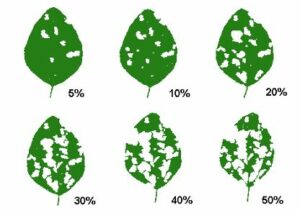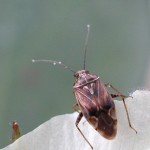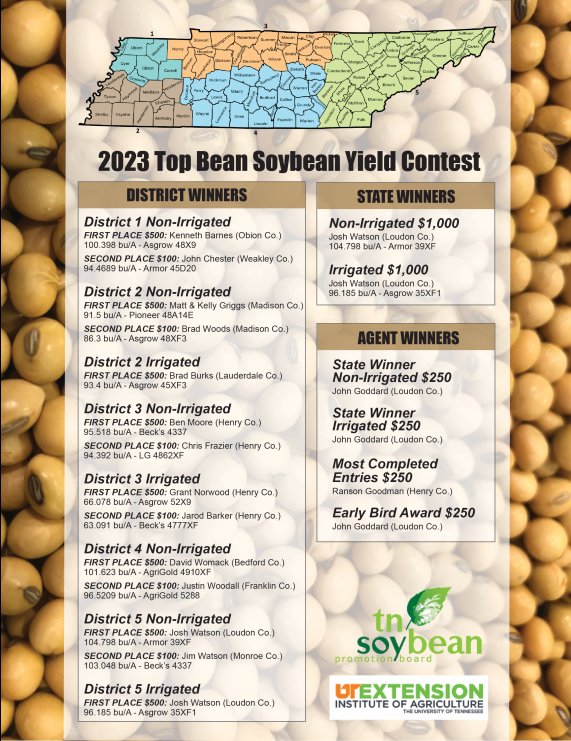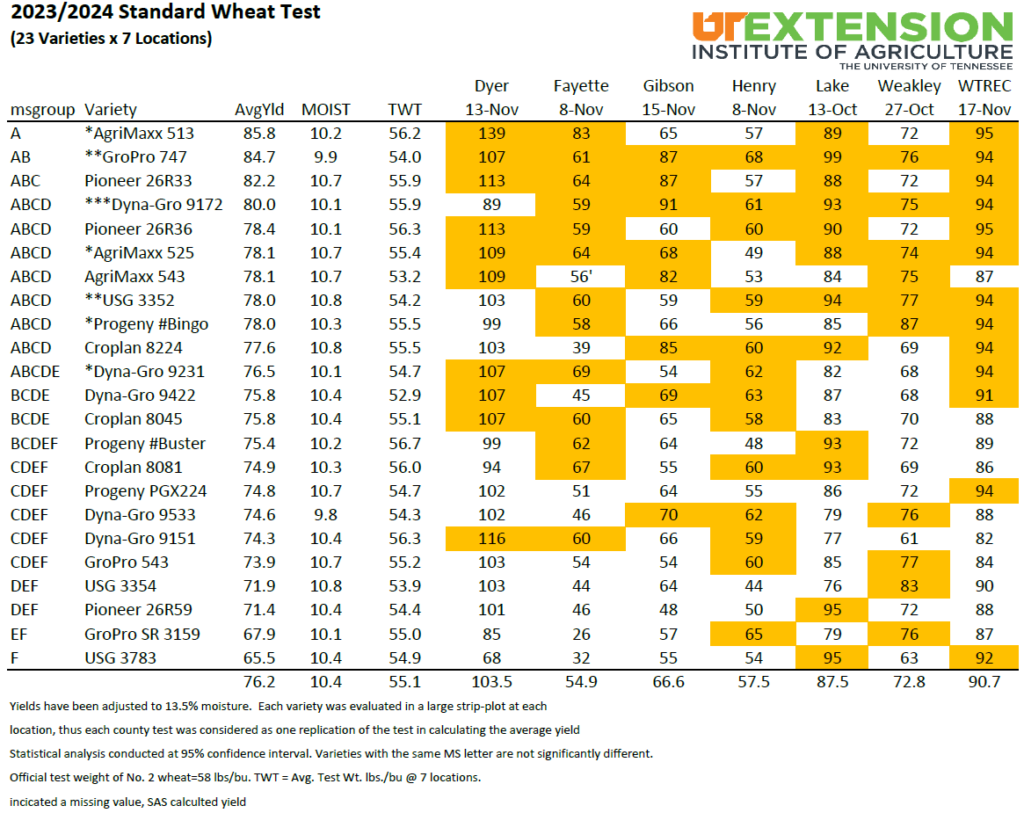| Location | CEW | TBW |
| Hardeman (Bolivar) | 2 | 0 |
| Fayette (Whiteville) | 2 | 0 |
| Fayette (Somerville) | 0 | 0 |
| Shelby (Millington) | 12 | 0 |
| Tipton (Covington) | 1 | 0 |
| Tipton (North) | 0 | 0 |
| Lauderdale (Golddust) | 4 | 0 |
| Haywood(West) | 0 | 0 |
| Haywood (Brownsville) | 0 | 0 |
| Madison (WTREC) | 19 | 0 |
| Madison (North) | 0 | 0 |
| Crockett (Alamo) | 0 | 0 |
| Crockett (Friendship) | 0 | 0 |
| Dyer (King Rd) | 0 | 0 |
| Dyer (Dyersburg) | 5 | 0 |
| Lake (Ridgely) | 10 | 0 |
| Gibson (Trenton) | 2 | 0 |
| Gibson (Milan Rec) | 0 | 0 |
| Carroll (Coleman Farm) | 1 | 0 |
Recent Updates
Budworm/Bollworm Catches 7/18
| Location | CEW | TBW |
| Hardeman (Bolivar) | 0 | 0 |
| Fayette (Whiteville) | 0 | 0 |
| Fayette (Somerville) | 1 | 0 |
| Shelby (Millington) | 1 | 0 |
| Tipton (Covington) | 1 | 0 |
| Tipton (North) | 0 | 0 |
| Lauderdale (Golddust) | 16 | 0 |
| Haywood(West) | 12 | 0 |
| Haywood (Brownsville) | 0 | 0 |
| Madison (WTREC) | 107 | 6 |
| Madison (North) | 2 | 0 |
| Crockett (Alamo) | 0 | 0 |
| Crockett (Friendship) | 1 | 0 |
| Dyer (King Rd) | 7 | 0 |
| Dyer (Dyersburg) | 5 | 0 |
| Lake (Ridgely) | 1 | 0 |
| Gibson (Trenton) | 4 | 0 |
| Gibson (Milan Rec) | 0 | 0 |
| Carroll (Coleman Farm) | 2 | 3 |
Considerations for PGRs and fungicides in an abnormally cool July
A drastic change in weather pattern has brought cooler temperatures and rainfall into the forecast for the remaining days of July. Recent calls have questioned how we might need to change our approach to plant growth regulation and fungicides, given this abnormal forecast. In this blog, I highlight a couple of things to consider as we move into next week. Continue reading
Bollworm/Budworm Trap Catches (7/12)
Bollworm/Budworm catches for the week of July 12
| Location | CEW | TBW |
| Hardeman (Bolivar) | 1 | 0 |
| Fayette (Whiteville) | 0 | 0 |
| Fayette (Somerville) | 2 | 0 |
| Shelby (Millington) | 2 | 2 |
| Tipton (Covington) | 1 | 0 |
| Tipton (North) | 2 | 0 |
| Lauderdale (Golddust) | 6 | 0 |
| Haywood(West) | 6 | 0 |
| Haywood (Brownsville) | 0 | 1 |
| Madison (WTREC) | 62 | 1 |
| Madison (North) | 32 | 0 |
| Crockett (Alamo) | 0 | 0 |
| Crockett (Friendship) | 1 | 1 |
| Dyer (King Rd) | 0 | 0 |
| Dyer (Dyersburg) | 1 | 0 |
| Lake (Ridgely) | 8 | 0 |
| Gibson (Trenton) | 0 | 0 |
| Gibson (Milan Rec) | 0 | 0 |
| Carroll (Coleman Farm) | 0 | 0 |
Fall Armyworms in Double Cropped Soybeans
I’ve received several reports, over the last two days, on fall armyworms (FAW) infesting double cropped soybeans. Almost every one of these calls were incidents of grass escapes and the lone exception was FAW migrating from a grass turn-row into v-stage beans. Somethings to keep in mind, vegetative soybeans can withstand 30% defoliation before yield loss and reproductive stage soybeans can withstand 20% defoliation before yield loss. Below is guide to help gauge defoliation levels.

If you do see armyworms it shouldn’t be automatically assumed that pyrethroids won’t be effective. We don’t fully understand why pyrethroids provided inconsistent control in 2021. Resistance is a possibility but overlapping generations causing mixing of various worm sizes resulting the appearance of poor control is another possibility. Also, since armyworms don’t overwinter in Tennessee and there is no evidence of reverse migration, the armyworms we experienced in 2021 won’t be the same ones we see in subsequent years. However, if pyrethroids do fail to control armyworms please contact your local county agent.
The FAW we are currently facing are the rice/grass strain, not the corn strain. They are impossible to distinguish visually but they are very host specific. Grass strain FAW almost always colonize grass, not soybeans, corn or cotton. Corn strain FAW almost always infest corn, soybeans or cotton not grass or rice. Another key difference is grass strain FAW are typically very susceptible to pyrethroids while corn strain are resistant. What happens when grass escapes occur in soybeans is the grass is controlled and FAW are forced off of a dying host on to soybeans. They don’t necessarily want to eat the soybeans but have no other options. If you have FAW in your fields and haven’t controlled grass yet, adding a pyrethroid would be a prudent step to save another potential trip. If you want other options outside of pyrethroids or are concerned they won’t work that list is here:
Acephate: 0.75 lb ai/ac,
Diamond: 6.0 fl oz/a,
Intrepid 4.0 fl oz/a,
Intrepid Edge 4.0 fl oz/a,
Vantacor 1.2 fl oz/a,
Elevest 5.6 fl oz/a,
Besiege 7.0 fl oz/a
Don’t automatically reach for the diamides (Vantacor, Elevest, Besiege) these products provide excellent FAW control but are costly. All of the above products will provide satisfactory control of FAW in soybeans.
Tarnished Plant Bug Considerations in Blooming Cotton

Tarnished plant bug numbers seem to be all over the board in 2024. Some fields have one spray since square set and others have had upwards of five. Crop age and what’s neighboring your cotton play a large part of how intense plant bug pressure is over time. That being said, keeping an eye on square retention is the best gauge to determine how well your insecticides are performing. Most I’ve talked to have applied Diamond at least once since first bloom. Diamond shines when you catch early plant bug hatches often after large adult migrations during late squaring and we see a good ROI with Diamond around that 1st week of bloom timing.
Going into bloom, I don’t think neonics have a fit in any scenario. Every time we test a neonic sprayed after bloom its often one of, if not, the worst treatments in the test. Once you see a flower migrate to the Transform, Acephate, Bidrin treatments. Pyrethroids can be added in with OP’s to help increase control and acephate + pyrethroid can catch a few bollworms in the top of the canopy if you’re close to cut out (although our 3 gene cottons are doing a great job of controlling bollworms). Diamond should rotated around in the bloom mix also. Overlapping Diamond residual, usually spaced out every other shot, can help reinforce control of nymphs. I don’t like Diamond fb Diamond in succession. Diamond’s effects may take 7 to even 10 days to notice and sequential shots may not take full advantage of the residual it provides, but that’s situation dependent.
Thryvon bloom performance is on par with what we’re accustomed to seeing. Square retention is often better in Thryvon and plant bug numbers, especially nymphs, are lower. Insecticides seem to perform better in Thryvon for a couple of reasons. Less insects are typically easier to control, plant bug population growth is slower and we think the nymphs don’t settle in bracts/blooms like they do in non-Thryvon. Nymphs are constantly moving in Thryvon and the more they move, the higher likelihood they’ll encounter an insecticide. Final note, Thryvon has minimal, if any, activity on stink bugs and if you’ve gotten by without using a broad-spectrum insecticide mid to late bloom, I would add an OP or pyrethroid to clean up any building/lingering populations.
Tennessee ‘Top Bean’ Soybean Yield Contest
The Tennessee Top Bean soybean yield contest sponsored by the TN Soybean Promotion board and coordinated by UT Extension is open for entries now until September 1st for the 2024 season.
2024 County Standardized Trials-Wheat data
This year’s County Standardized Trials, Wheat Program tested 23 varieties of Soft Red Winter Wheat in 10 locations. Seven of those locations where used to compile our variety recommendations for the 2024 fall planting. Over all, yields across varieties and locations averaged just over 76 bu/ac, with an average of 10.4% moisture and 55.1 lb testweight.
Thank you to all the producer who put these trials out and the County Agents who organized and oversee these variety plots. Also, a special thanks to our cooperating companies who supply seed and genetics to test in our environment. Wheat yields have increased dramatically over the years, better genetics and breeding programs along with state and local testing are proving to add weight to the combine and increase profits for wheat growers in TN.
If you are interested in having a County Standardized Trial (Corn, Soy, Cotton, Wheat) on your farm, contact your local County Extension office for more details.
This Fall, contact your seed suppliers and request wheat seed from the list above with confidence from our unbias variety testing program.



